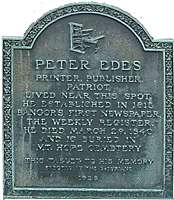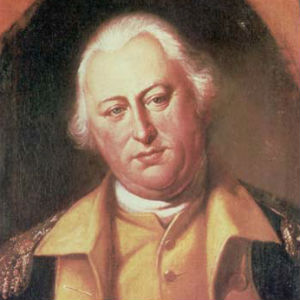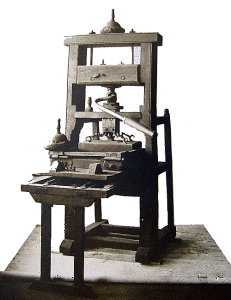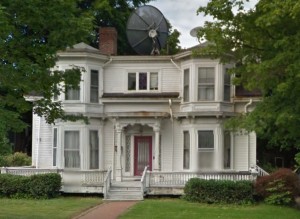Peter Edes Revolutionary War Patriot and Founder of Bangor’s First Newspaper
On the corner of Hammond and High Streets, in front of the Hammond Street Congregational Church, is a historical marker dedicated to the man who published Bangor’s first newspaper, Peter Edes.
While his legacy as the first printer in Bangor, publisher of the Queen City’s first newspaper and one of Maine’s first publishers is important, his direct connection to the events that resulted in the formation of the nation are lesser known.
The son of one of the most prominent Sons of Liberty, Benjamin Edes, at the age of 16 Peter was dubbed a “Boston Bad Boy” by British General Thomas Gage because of his unabashed views and comments.
Benjamin Edes, also a printer, was a well-known Patriot in Boston. On December 16, 1773, a number of men including John Hancock and John Adams gathered at Edes’ Brattle Street home. They were served punch by an almost 17-year-old Peter from the Edes Family punch bowl before moving on to Benjamin’s Queen Street printing shop, disguising themselves as Indians and heading to Boston Harbor.
What happened next was key in the formation of our nation’s history and is known as the Boston Tea Party. It’s one of the reasons Benjamin Edes is known as the ‘Father of the Boston Tea Party’.
Raised around such emphatic patriotism, it’s not surprising that young Peter shared many of his father’s views. During the Battle of Bunker (Breed’s) Hill, British soldiers overheard Peter’s “enthusiastic patriotic utterances” from his viewing point on Copp’s Hill. Two days later he was arrested, charged with possessing firearms and imprisoned for three and a half months. Peter kept a diary during his imprisonment that detailed the horrific mistreatment of prisoners. His diary is now part of the collection of the Massachusetts Historical Society.
Peter’s strong views, and unapologetic expression of them, would follow him throughout his life.
After his imprisonment, Peter apprenticed with his father before opening his own Boston printing shop in 1784. He closed that shop in 1786 and moved on to open shops in Newport, Rhode Island and Augusta, Maine before coming to Bangor in 1815.
When he decided to move to Bangor, he hired a team of six oxen to haul his printing press and equipment north. The 12 day journey cost $143—almost $2200 in today’s dollars. He opened his shop at 43 Main Street, now the site of Rebecca’s, and lived on Ohio Street.
The Bangor Daily Register printed its first edition on November 25, 1815. Edes charged a $2 annual subscription fee, but accepted payment in the form of “wheat, butter, cheese or rags”.
Sadly, after only two years he sold the paper. He wanted to expand the business to printing books and pamphlets and there simply wasn’t enough demand in the area.
It was a decision he personally regretted and in 1832, at age 76, Peter Edes returned to the Queen City. He would spend his last eight years living with one of his daughters and her family in a home next to the one he used to own. At the time of his death in 1840, Peter Edes was the oldest living printer in the United States. He is buried in Mt. Hope Cemetery.
Edes printing press and editorial chair from the Bangor Daily Register were donated to the Bangor Historical Society. Unfortunately, those were two of the items destroyed in the Great Fire of 1911 when the BHS lost its entire collection.
The location of the historical marker in front of the Hammond Street Congregational Church isn’t as misplaced as it may seem. The marker was placed there because it was within sight of Edes’ beloved Ohio Street home.
This “Bangorism” is brought to you through a partnership with Tricia Quirk Real Estate and the Bangor Historical Society.













A wonderful look back into Bangor’s history and the connection Bangor’s first newspaper had to The Sons of Liberty, The Boston Tea Party, and some of the patriots who played significant roles in the forming of our country. I would say that being dubbed a “Boston Bad Boy” by a British General of that time was a Badge of Honor in the fight against the British. Disguising themselves as Indians to make their way to the printing press is a fascinating detail and one can imagine doing such things in similar circumstances. Peter Edes diary, the family punch bowl, his Ohio Street home, his printing press and editorial chair are all amazing items to have kept for future generations to muse over and let their imaginations wonder about the people and events that surrounded these pieces. The tragedy of the loss of the Bangor Historical Society’s collection in the 1911 fire cannot be measured. It is painful now to think of by someone such as myself who was not even born until 47 years after that fire. Stories such as this help to keep that history alive in the minds of the generations who will follow. Thanks for sharing this history.
Thank you for your comment, Mike. I’m glad you like the story. I found it to be a fascinating piece of Bangor/New England history.
Tricia, I found your article most interesting as both Peter and Benjamin are ancestors of mine, and even though the fire of 1911 claimed the printing press and editorial chair, there are a number of items that it missed. Two of those are two chairs that have been passed down through the family into my possession a number of years ago that belonged to Benjamin. I have researched the Edes family for many years trying to establish my relationship to Benjamin, as I have the same first name, and one of my middle names is Edes, hence my curiosity at a young age as to its origin. Benjamin is my great grandfather 7 generations back.In your article you have an image of Benjamin Edes. May I ask where it came from and its veracity or provenance. For years I have been trying to find images of these ancestors and I saw this and wondered. Any information would be greatly appreciated.
With thanks
Benjamin Long Edes Talman
Sydney, Australia
Hi Ben – so sorry for the length of time to reply. Your comment got mixed in with the spam. The historical data and images came from the Bangor Historical Society. They would probably be your best point of contact for more information. Glad you enjoyed the article and good luck with finding out more about your ancestors! http://www.bangorhistoricalsociety.org/
As the current owner of the Peter Edes house at 23 Ohio Street, Bangor, for the past 35 years, it has been a source of pleasure to learn of it’s historical past over the years. I was completely unaware of the fact that the house was the second oldest house still in existence in Bangor and that it was originally owned by the man, who printed Bangor’s first newspaper back in the day when Bangor’s 2000 or so citizens had aspirations of breaking away from Castine as the county seat at that time. Actually built by house wright Michael Sargent, from whom the plot of land on which it was built (Sargent also owned the house lot next door upon which he later built his own home, and married Peter Edes’s daughter Marie. And a few years later, after Peter and his wife had moved to Baltimore to join is son’s print shop there, only to lose his son and wife in a dreaded typhoid epidemic, the now widowed Edes returned to Bangor to live with his daughter Marie and his son in law Michael Sargent until Edes’ death and burial in the Sargent family plot in Mount Hope Cemetery) Of further interest is the fact that Michael Sargent purchased his house lots on Ohio Street from Charles Hammond, who was a wealthy speculator out of Boston who invested in several plots of land around Bangor after the early city had been surveyed and laid out by Park Holland. In 1815 the Edes home was one of the first to be built on the County Road , which became Ohio Street. Originally a single story house, in 1900 the roof was elevated and many gentrified improvements made by Augustus Babcock, a prosperous local fuel dealer, to keep pace with, what at that time, was an affluent area with the street lined by lofty Elm trees. In my opinion the house should now be identified as the Peter Edes/ Augustus Babcock house, since both men are responsible for its current appearance and claim to architectural fame.